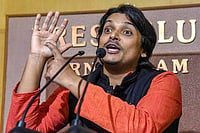
| Sachin hits the winning runs |
Just what sort of mind could think up something as simply ingenious as this and actually manage to implement it without a Plan B? Perhaps the only one who approaches the gentleman's game with the hunter's instinct blended with the credo of aristocratic leisure—pleasure, pure and simple, married to purpose. Perhaps only the Nawab of Najafgarh, whose ruggedly simple approach hides a razor-sharp cricketing mind. Little wonder, after India won the Chennai Test against England on the back of an electric 83 from him, Mahendra Singh Dhoni said: "Of course, Sachin and Yuvraj batted really well to finish off the match. But they were able to do that because of the start given by Sehwag. Without him, we would have been defending the match."
Welcome to a distinctive ethos of cricket that is gaining fans with every cut, drive and loft. It is called Sehwagism. It means that its practitioner takes the rule book, tears it up, and traduces every principle. Implicit in this credo is the greatest possible belief in your own abilities, and none for your foe's record or reputation. It involves making choices and sticking to them. It means not allowing kindness to trespass between you and the bowler.
In a sport governed by laws, Sehwag has made it legal to think the unthinkable. If the ball is on the stumps or at good length, he'll defend or drive. If it's up, he'll whack. If it's short and wide outside off, he'll attempt to pound it to cover or third man. If it's short and on the wicket, he'll try to send it soaring over the midwicket boundary.
And Sehwag will employ the said method in whatever format of the game he chances to be playing in—Tests, one-dayers, or Twenty20. Against anybody, anywhere. Wearing pitch on the fourth day? No problem. Facing the new ball? No thought of curtailment. Shadows lengthening? Nothing darkens his mind. He'll farm all of the wide, unhindered swathe he has scythed for himself.
Generations of fans and followers have been brought up on the old mantra of opening batsman. Of respectfully playing in the 'V'. Of not hitting in the air. Of giving the first hour to the bowler and taking the remaining five. Of taking the shine off. Sehwag begs to differ, in a manner that leaves most coaches cringe in insecurity.
That's why he perishes at 195, attempting a six; that's also why he reaches a triple century with a six. A man who doesn't play with tomorrow's newspaper layouts in mind is a man to be admired, and feared.
Coaches say you can't defy the tenets of the game. That if you do, you will perish, that you will be sorted out. Yet, Sehwag presents a strange conundrum. "Primitive" technique, yet such big scores, and two triple centuries in Test cricket! He gives us thrillers, but not cameos. He's a master of the long-playing thriller. He's got the only triple-century to be scored at over a run a ball, and three of the seven fastest double centuries are owned by him.
There are other openers around who murder bowlers, but Sehwag's figures tell a different tale. Matthew Hayden? Sehwag gets 19 more runs than Hayden does every 100 balls. Graeme Smith? Mind the gap (seeUnitedRacers Of Cricket).
So, has Sehwag rewritten the grammar that governed generations of Test openers? Viru is post-modernist, post-Wren & Martin. But simple, not complex. Deeds, not words. "I believe in performance, not technique," he says.
Sehwag's game, with its casual indifference to his own fate or that of bowlers, harks back to the days when he was really young, when he must have played only for joy. Ten years after he made his international debut, Sehwag's game remains soaked in sunlit youth, and that imparts beauty to its nonchalance.






















